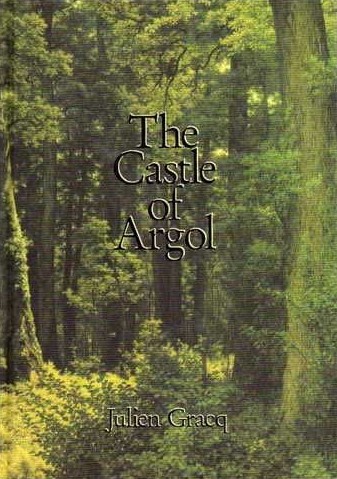 By JULIEN GRACQ (The Lapis Press; 1938/91)
By JULIEN GRACQ (The Lapis Press; 1938/91)
This French novel is perhaps the most famous work of gothic surrealism. Many literary-minded horror mavens all-but swear by it, and I know of one learned essay entitled “Surrealism and Modern Horror Literature” (found in NYCTALOPS 18) that largely confines itself to just one book: this one.
THE CASTLE OF ARGOL (AU CHATEAU D’ARGOL) certainly has a gothic flavor. Its own author, whose first novel this was, has this to say about his “slight narrative”: “Let there be mobilized here the potent marvels of the MYSTERIES OF UDOLPHO, of the CASTLE OF OTRANTO, of the HOUSE OF USHER…the author will only be paying them tribute, deliberately explicit, for the spell they have always inexhaustibly cast over him.” I think that best sums up the charms of this novel, whose reputation has in my view grown a bit outsized over the years.
Julien Gracq—real name Louis Poirier—is often cited as one of the finest living French novelists (other Gracq novels include THE DARK STRANGER and THE OPPOSING SHORE), and his abilities are in ample evidence here. The indescribably lush, sensuous prose, brilliantly translated by Louise Varese, is utterly distinct, related in wildly opulent, adjective-packed sentences. So supple is the writing that one is nearly seduced into overlooking the fact that the narrative is painfully thin.
It goes like this: a modest guy named Albert purchases an old castle situated in a vast, suffocating forest. Soon Albert’s lifelong pal Herminien comes to stay, together with his girlfriend Heide. Albert and Heide fall head over heels for one another, and Herminien, inflamed by jealousy and the elemental grandeur of the woodland surroundings, takes Heide into the forest and kills her. But Heide’s ghost pervades the castle, driving a wedge between the two men—hence the bloody but inevitable finale.
In keeping with the gothic aura, there’s a graveyard that figures heavily (complete with a headstone marked HEIDE, a none-too-comforting premonition) and a hidden passageway inside the titular abode. Such things, alas, seem conjured more for decoration than anything else.
I’d also argue against this being an authentically surrealist text. Yes, Julien Gracq was close to the surrealists and even dedicated the novel to Salvador Dali. The book also has a hallucinatory grandeur that can only be called deeply strange. But it’s in service of a fairly run-of-the-mill gothic melodrama with little in the way of the reality distortion that characterizes true surrealism (as exemplified by Lautremont’s MALDOROR and Giorgio De Chirico’s HEBDOMEROS). In other words, THE CASTLE OF ARGOL is an impressive accomplishment in its own way, but those looking for a real work of gothic surrealism had best set their sights elsewhere.
